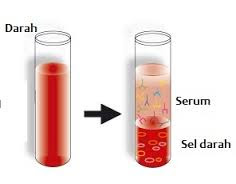Plasma.
Is the liquid component of blood, comprising 55 percent of the total blood volume. Plasma can be separated artificially by rotating or centrifugation of blood at a high rotation of 3000 rpm or higher. Blood cells and platelets that make up about 45 percent of blood is separated by centrifugal force to the bottom of the tube specimen, leaving the plasma as a top layer. Plasma consists of 90 percent water along with various substances needed to maintain the body's pH, osmotic load, and to protect the body. Plasma also contains coagulation factors and antibodies.
Serum.
Is a blood plasma component that does not have a coagulation factors, similar to interstitial fluid where the exact composition of the key acts as an electrolyte ions are essential to the normal functioning of muscles and nerves. Other components include proteins in serum, which helps maintain the pH and the osmotic balance when giving blood viscosity, antibodies, or specific proteins that are important for the defense against viruses and bacteria, lipids, including cholesterol, are transported in serum; and various other substances, including nutrients, hormones, metabolic waste, and external substances, such as drugs, viruses, and bacteria.Albumin.
Human serum albumin, the most abundant protein in human blood plasma, are synthesized in the liver. Albumin, which is about one-half of blood serum proteins, transporting hormones and fatty acids, buffer pH, and maintain osmotic pressure. Immunoglobulin, an antibody protein produced in the mucosal layer, plays an important role in the immune antibodies.Summary of Differences in Blood Serum and Plasma.
Plasma, the liquid component of blood, comprising 55 percent of the total volume of blood.
Plasma consists of 90 percent water with antibodies, coagulation factors, and other substances such as electrolytes, lipids, and proteins needed to keep the body.
Elimination of plasma coagulation factors from the leaves of a fluid similar to interstitial fluid, known as serum.
Albumin, a protein produced in the liver, consisting of approximately one-half of blood serum protein, serves to maintain osmotic pressure and to transport hormones and fatty acids.
Immunoglobulin antibody is a protein produced in the mucosal layer, plays an important role in the immune antibodies.
Function Blood In Humans.
Blood function very much but basically can be divided into two major parts. Blood to carry something into the various tissues of the body, and also eliminate something from body tissues. Perhaps the most easily remembered than the function of blood is a never-ending series such as car or train to its rails running through the transport network is very large. In this sense, "train" constantly either provide the necessary elements or carry away the substances produced by the body.As part of tranport system, there is a lot of blood function. What is important among these is to provide oxygen to the entire network, because there is no area of the body that can survive without a regular supply of oxygen. This is not the only important function of blood. Other things that travel in the blood include hormones, nutrients, temperature control element, and various forms of food, such as minerals and vitamins.
Some types of blood cells act only when the body needs it, and this is one of the main functions of blood. If the bacteria enter the body, white blood cells arrive to fight it. Injury requires cells and materials to aid blood clotting. These cells are not separated from the other blood and constantly traveling along it. If seen bleeding from cuts, people can not see the cell as part of a different, but under a microscope, it is easy to see there are many elements that make up the blood. With all of these elements go together, they are ready to work in a way that is needed when needed, and these additional functions "required" could be called a special delivery, based on the state of the individual's body.
It was clear then, that one of the functions of blood is to work as a transport system, but the transport network has another important job. It should also be capable of cleaning substances produced from the body or eliminate unnecessary. Various types of waste carried by the blood and can eventually expelled from the body or is converted through a chemical process. Blood also have to get rid of excess carbon dioxide that blood levels maintain normal pH balance.
When the function of blood suspected of inadequate or not normal, one thing that might be done is to test doctors complete blood count (CBC) or other medical tests to determine the efficacy of the blood and tissues. Doctors can for example see the veins and arteries to see if the narrowing create problems with the blood moving. In addition, they could see the blood itself to check their adequacy. Because so many parts of the body will not be able to do entirely dependent on this vital transportation system, the problem with it can be very important and in need of immediate repair or medical care.
Thank you for reading this article. Written and posted by Bambang Sunarno. sunarnobambang86@gmail.com
author:
https://plus.google.com/105319704331231770941.
name: Bambang Sunarno.
http://primadonablog.blogspot.com/2015/09/different-serum-and-plasma-blood.html
DatePublished: 11 September 2015 at 10:20
Tag : Difference Serum And Plasma Blood.
Code : 7MHPNPADAEFW

